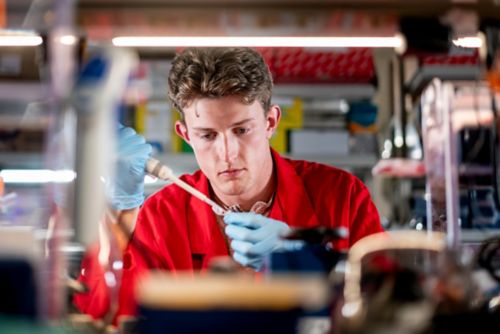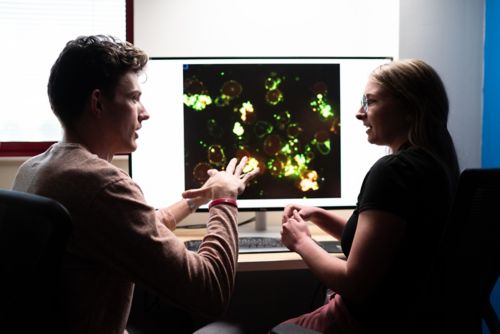St. Jude Family of Websites
Explore our cutting edge research, world-class patient care, career opportunities and more.
St. Jude Children's Research Hospital Home

- Fundraising
St. Jude Family of Websites
Explore our cutting edge research, world-class patient care, career opportunities and more.
St. Jude Children's Research Hospital Home

- Fundraising
Cancer survivor returns to St. Jude to pursue infectious disease research

Cancer survivor Evan Moore was inspired by the people he met at St. Jude who encouraged his interest in research and helped connect him to opportunities in the lab.
In the summer of 2023, 20-year-old Evan Moore noticed his running performance had taken a major hit. The elite NCAA track and cross-country athlete was struggling to run at his typical pace while training at home in Colorado. Moore initially attributed his poor performance to a lack of motivation and high-altitude training, among other things, but by Fall 2023, he knew something was amiss. He was suffering from a hamstring injury that wouldn’t heal, which led to him not making his university’s national team. He also had a swollen lymph node in his neck, which suggested that there may be more to his training struggles than he initially thought.
Two needle biopsies performed on Moore’s swollen lymph node came back normal, but by late Fall 2023, a lymph node on the other side of his neck also became swollen. One of Moore’s doctors decided to run a full panel of tests looking for possible infection, but those all came back negative.
Moore recounted going back to the doctor who originally did his lymph-node biopsy, “That’s when he told me that I could have a rare case of Hodgkin’s lymphoma where I’m asymptomatic. As soon as he said those words, something in me knew that’s what I had.” A third biopsy confirmed that diagnosis.
Though relatively rare, Hodgkin lymphoma is one of the most common cancers in adolescents and young adults. Tumors typically form in the lymph nodes due to a DNA mutation that promotes the uncontrolled growth of B lymphocytes (B cells), which are immune cells that make antibodies to help fight infections.
Specifically, Moore had stage 2A Hodgkin lymphoma. Of the four classification stages, stage 2 indicates that cancer was found in at least two lymph node areas on the same side of the diaphragm. The “A” stands for asymptomatic since Moore did not experience the typical fever, night sweats, and unexplained weight loss that normally accompany the disease. Due to his age and cancer staging, Moore qualified for a study taking place at St. Jude Children’s Research Hospital.
Coming to St. Jude for Hodgkin lymphoma treatment
With treatment, 90% of stage 2 Hodgkin lymphoma patients survive; however, cancer treatments, such as radiation therapy, can cause growth and organ issues and secondary cancers later in life, conditions collectively called “late effects.” The cHOD17: Risk-Adapted Therapy for Children and Young Adults with Hodgkin Lymphoma clinical trial at St. Jude aims to determine if less aggressive treatments can cure the cancer but avoid or diminish late effects.
Moore was initially hesitant to pursue treatment so far from home, but after meeting Matthew Ehrhardt, MD, MS, Departments of Oncology and Epidemiology & Cancer Control, he was convinced he wanted to join the cHOD17 trial cohort. “Dr. Ehrhardt told me the plan was to start with chemo and then, at the two-month mark, if I didn’t have any cancer left, I wouldn’t have to do radiation. If you go anywhere else, radiation is not optional; it’s protocol,” Moore recalled. “St. Jude is looking at my health 20 to 30, or even 50 years down the road, not just right now. That was a huge deal to me.”
Moore spent the spring semester of 2024 receiving treatment at St. Jude, during which he and his dad lived in Memphis with regular visits from his mom. Despite being a young adult with cancer, he remained positive. “Having to get chemo was kind of like a job. I just had to get it done,” said Moore. Luckily, his body handled the chemotherapy well, and he did not require radiation treatment.
“I never lost my hair completely, and I think because of my health prior, being a distance runner, my body was prepared for something really hard,” Moore said. In addition to being an accomplished athlete, Moore is also a self-declared nerd. When he initially had his lymph node biopsied, he had asked the surgeon to take a picture so that he could see what it looked like after the surgery. Similarly, once he was at St. Jude, he inquired if he could have a slide or a photo of his tumor pathology.

An image of Evan’s tumor hanging as art in his room. A connection with pathologist Cliff Guy, PhD, helped connect him to research at St. Jude. Image courtesy of Evan Moore.
His request led to him getting a tour of the St. Jude Department of Pathology research labs, where they did, in fact, provide him with a keepsake slide of a stained section of his lymph node. He also got to meet Cliff Guy, PhD, Director of the St. Jude Immunologic Imaging Center in the Department of Immunology, who agreed to image his slide.
“I actually have a print of my cancer in my room. It’s a purple H&E (hematoxylin and eosin-stained) classic slide, but it looks like a piece of art. If you walk past it in the house, you would never know that it’s Hodgkin’s lymphoma, let alone mine,” recounted Moore.

Torres Lab summer student interns Evan Moore and Mikayla Harden-Pruitt discuss their work.
Returning to St. Jude as a summer research intern
As a Health Science major at Lee University in Cleveland, TN, Moore was already interested in pursuing microbiology research when he received his cancer diagnosis. However, he had to put those plans on hold while receiving treatment.
Moore’s time at St. Jude as a patient and his introduction to immunological imaging through Guy further confirmed his research interests. “It solidified in my mind that I wanted to do something in the sciences, and I think the biggest part of that was meeting Dr. Guy,” said Moore.
Guy was the one to suggest that Moore pursue a research internship at St. Jude. It was through a chance meeting at the Crosstown Concourse last year during Moore’s chemotherapy treatment that Guy introduced Moore to Victor Torres, PhD, Department of Host–Microbe Interactions chair. Torres eventually agreed to host Moore as a research intern in the summer of 2025.
In June, Moore returned to the St. Jude campus, this time as a researcher, where he is studying host–pathogen interactions in the Torres Lab. His summer project involves imaging the interaction between methicillin-resistant Staphylococcus aureus (MRSA) bacteria and host immune cells. This project will allow him to team up with Guy and generate scientific images of his own.
In addition to acquiring some new science-themed art, Moore hopes to come away from this research experience with new perspectives that make him a better scientist. “I just want to come out of it with a fresh mindset where I’m asking more questions, but also more informed questions,” said Moore.
The opportunity to do research at St. Jude, after all he has been through, is not lost on Moore. “I’m picking up things quickly, but it’s so cool to be in an environment like this with such brilliant people as an undergrad. It’s such an amazing experience to work with Dr. Guy, Dr. Torres and other brilliant people in the HMI department.”
Reflecting on his diagnosis, Moore stated, “It is definitely an interesting experience, but the first thing I tell people is that I wouldn’t take it back. I’m a better person because of it. I’m where I’m at right now, sitting here in this research lab, because of that experience. So, there are good things to come out of it.”
April 2025 marked the first anniversary of Moore finishing his chemotherapy treatment. He is now in full remission, and the cancer is not expected to return.
As for his running, Moore happily reported, “I'm in the best shape of my life. I ran at nationals this last track season and was top 20 in the country for the 1500-meter event in Division 2. I’m doing better than I was before.”






